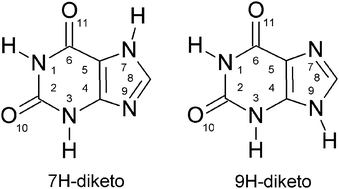Photophysics of xanthine: computational study of the radiationless decay mechanisms
21-Sep-2009
Phys. Chem. Chem. Phys., 2009, 11, 10165-10174 published on 21.09.2009
Phys. Chem. Chem. Phys.
A comprehensive investigation of selected excited states of xanthine has been performed with the CASSCF, CASPT2, CC2 and ADC(2) methods. The 7H-diketo and 9H-diketo tautomers of xanthine, which are the lowest-energy tautomers in the ground state, have been studied. A comprehensive investigation of the 1ππ*, 1nπ* and 1πσ* excited states of xanthine has been performed with the CASSCF, CASPT2, CC2 and ADC(2) methods. The 7H-diketo and 9H-diketo tautomers of xanthine, which are the lowest-energy tautomers in the ground state, have been studied. Out-of-plane deformation of the purine system in the lowest 1ππ* state as well as dissociation of the NH bonds in the lowest 1πσ* state have been considered. Several conical intersections between the 1ππ* and S0 energy surfaces have been located. It has been found that the out-of-plane deformation occurs in the five-membered ring. With respect to out-of-plane deformation in the 1ππ* state leading to the 1ππ*–S0 conical intersections, the 7H-diketo tautomer exhibits lower energy barriers than the 9H-diketo tautomer. On the contrary, for NH dissociation in the 1πσ* state, the 7H-diketo tautomer exhibits a substantial energy barrier, while the decay of the 9H-diketo tautomer is essentially barrierless. On the basis of the computational results, we assign the observed R2PI spectrum of xanthine to the 7H-diketo tautomer, in agreement with the assignment of Callahan et al. (Phys. Chem. Chem. Phys., 2007, 9, 4587–4591).



